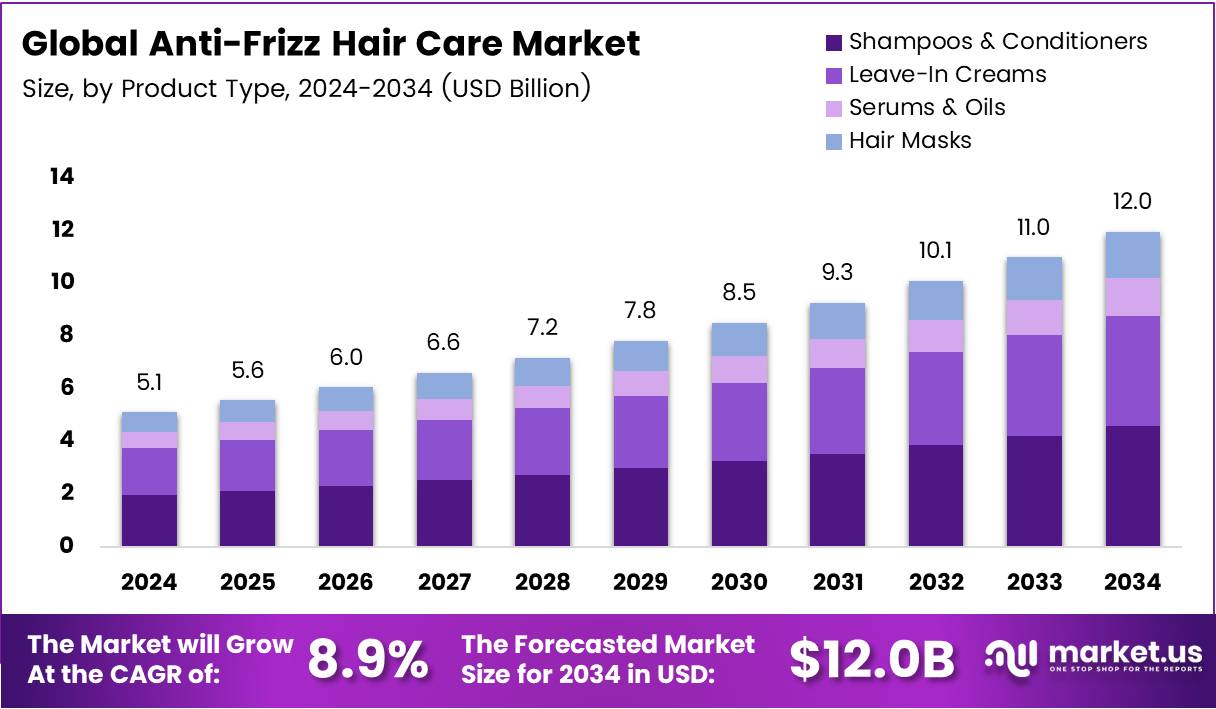Table of Contents
Introduction
The Global Anti-Frizz Hair Care Market is witnessing remarkable expansion, projected to reach USD 12.0 Billion by 2034, rising from USD 5.1 Billion in 2024. Driven by the increasing prevalence of frizz-related issues, brands are responding with advanced, science-backed, and personalized formulations.
Moreover, consumers are gravitating toward sulfate-free, vegan, and silicone-free products that align with sustainable beauty values. As eco-friendly packaging and clean formulations gain traction, companies integrating these innovations are securing strong market positioning and long-term customer trust.
Additionally, digital transformation is reshaping consumer engagement. Brands adopting AI-based hair diagnostics and e-commerce strategies are achieving higher personalization and accessibility, ensuring strong growth momentum during the 2025–2034 forecast period.

Key Takeaways
- The Global Anti-Frizz Hair Care Market is projected to reach USD 12.0 Billion by 2034, up from USD 5.1 Billion in 2024, growing at a CAGR of 8.9% during 2025–2034.
- In 2024, Shampoos & Conditioners dominated the By Product Type segment with a 38.2% share.
- Curly & Wavy Hair led the By Hair Type segment in 2024 with a 49.6% share.
- The Women category captured a 51.8% share in 2024 under the By End User segment.
- E-Commerce emerged as the top Distribution Channel in 2024 with a 34.4% share.
- North America dominated the global market with a 42.7% share and revenue of USD 2.1 Billion.
Market Segmentation Overview
By Product Type, Shampoos & Conditioners maintained dominance in 2024, accounting for 38.2% of market share. Their daily usability, affordability, and essential role in frizz management have positioned them as household staples across regions, boosting accessibility and consumer loyalty globally.
In the By Hair Type segment, Curly & Wavy Hair held a 49.6% share in 2024, owing to its high susceptibility to dryness and frizz. Increasing acceptance of natural curls and demand for specialized care products continue to propel growth across premium and mass-market categories.
By End User, Women led the market in 2024 with a 51.8% share. Their frequent use of styling tools and exposure to environmental factors fuel demand for frizz-control formulations. Brands targeting this demographic through tailored solutions are capitalizing on strong purchasing behavior.
By Distribution Channel, E-Commerce dominated with a 34.4% share in 2024. Digital platforms provide easy price comparisons, diverse brand access, and doorstep delivery, enhancing convenience. Meanwhile, online engagement and influencer-driven marketing amplify sales and brand awareness across key demographics.
Drivers
Rising Consumer Demand for Climate-Adaptive Hair Solutions
The growing awareness of humidity and weather-induced frizz is driving demand for adaptive, humidity-resistant hair care. Consumers are increasingly opting for formulations that ensure smoothness and shine despite environmental challenges. This climate-driven preference is reshaping product innovation strategies worldwide.
Shift Toward Clean and Sustainable Beauty
The clean beauty movement has significantly influenced consumer preferences. Products that are sulfate-free, paraben-free, and silicone-free are becoming mainstream. Brands reformulating with plant-derived actives and eco-conscious packaging are gaining credibility, fostering long-term trust among environmentally aware consumers.
Use Cases
Personalized Hair Diagnostics and AI Solutions
With AI-powered hair analysis, brands now deliver hyper-personalized product recommendations based on texture, climate, and hair concerns. This innovation enhances customer satisfaction, supports product differentiation, and strengthens loyalty through data-backed, custom-tailored anti-frizz routines.
At-Home Frizz-Control Treatments
Consumers increasingly prefer at-home salon-grade treatments for convenience and affordability. DIY smoothing kits and leave-in serums provide long-lasting results, reducing salon dependency. This shift supports the rise of multifunctional, professional-quality products for everyday use.
Major Challenges
Regulatory Restrictions on New Ingredients
The stringent approval process for novel actives and formulations remains a barrier to innovation. Lengthy compliance timelines limit agility and delay product launches, constraining companies aiming to introduce specialized or region-specific anti-frizz solutions.
Performance Variability Across Hair Types and Climates
Anti-frizz products perform inconsistently due to differences in texture, porosity, and local weather. This variability affects consumer confidence and repeat purchases, compelling brands to refine universal yet adaptable product formulations.
Business Opportunities
Hybrid Formulations Offering UV and Pollution Protection
Developing hybrid anti-frizz products that also shield against UV radiation and pollution presents new growth avenues. Consumers seek all-in-one solutions that simplify routines while providing holistic hair protection, driving the multifunctional product trend.
Expansion in Men’s and Gender-Neutral Segments
The men’s grooming category is evolving rapidly, creating untapped opportunities in frizz management. Gender-neutral formulations with minimalist designs appeal to both men and unisex buyers, expanding the overall customer base and boosting inclusivity.
Regional Analysis
North America Leads the Market
North America, holding a 42.7% market share worth USD 2.1 Billion, remains the largest regional market. High consumer awareness, ingredient transparency, and advanced formulations drive demand. The U.S. continues to witness growing adoption of premium, performance-oriented frizz-control products.
Asia Pacific Exhibits Robust Growth
Asia Pacific demonstrates accelerated growth fueled by rising disposable incomes and professional haircare adoption. Countries like China, Japan, and South Korea show significant demand for anti-frizz solutions due to humid climates and increasing influencer-driven awareness.
Recent Developments
- In July 2024, Moxie Beauty raised USD 2.1 million led by Fireside Ventures to enhance product innovation and expand digital marketing reach.
- In December 2024, Arata secured USD 4 million in Series A funding led by Unilever Ventures, supporting R&D and retail expansion.
- In July 2025, L’Oréal acquired Color Wow, aiming to strengthen its professional portfolio and leverage advanced frizz-control and color-protection technologies.
Conclusion
The Global Anti-Frizz Hair Care Market is entering a dynamic growth phase, propelled by clean beauty innovation, digital transformation, and hybrid product development. With a projected CAGR of 8.9%, the market’s evolution is anchored in sustainability, personalization, and scientific efficacy.
As consumer expectations rise, brands integrating AI-driven diagnostics, green chemistry, and multifunctional benefits will lead the next decade. By embracing transparency, inclusivity, and eco-conscious innovation, companies can capture long-term value in the expanding global anti-frizz hair care landscape.
Discuss your needs with our analyst
Please share your requirements with more details so our analyst can check if they can solve your problem(s)



